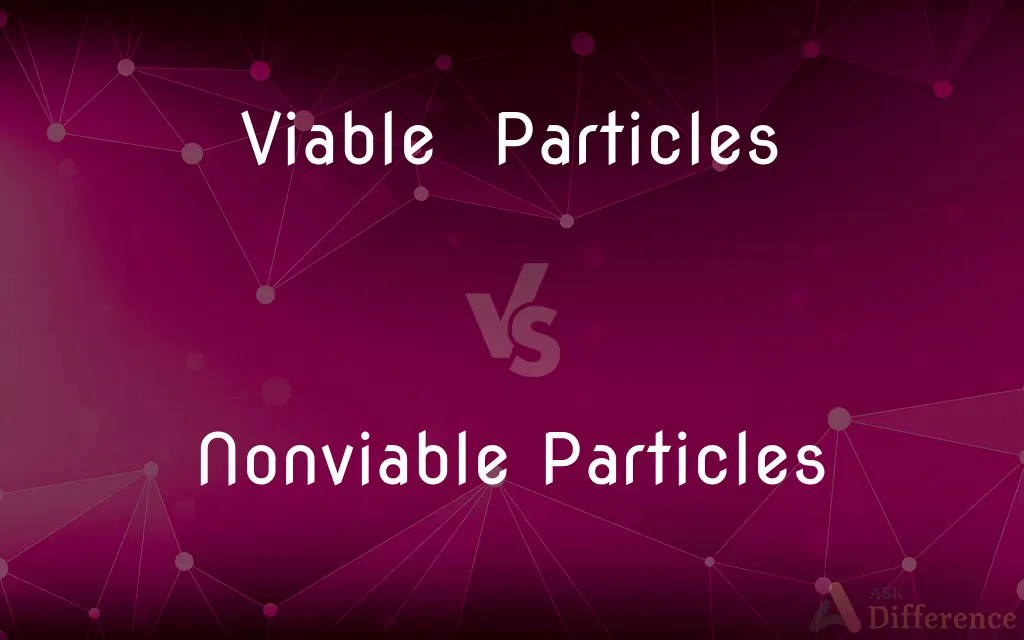Viable Particles vs. Nonviable Particles — What's the Difference?
Edited by Tayyaba Rehman — By Fiza Rafique — Published on December 6, 2023
Viable Particles are living organisms capable of growth and reproduction; Nonviable Particles are inactive or dead, lacking these capabilities.

Difference Between Viable Particles and Nonviable Particles
Table of Contents
ADVERTISEMENT
Key Differences
Viable Particles, as the term suggests, are living microscopic entities that retain the ability to grow, reproduce, and function. They are active and can influence their environment, often seen in contexts like air quality, where bacterial or fungal spores may pose health risks.
On the contrary, Nonviable Particles are those that lack life or the potential for biological activity. These particles, while present, don't possess the ability to grow or reproduce. In various scientific or industrial contexts, these particles are often counted to assess cleanliness or purity but are not a concern from a biological activity standpoint.
When assessing environments like clean rooms or medical facilities, both Viable Particles and Nonviable Particles come into the picture. Viable particles, like bacteria or molds, can contaminate products or harm patients. Nonviable particles, on the other hand, can affect the physical properties of products, potentially degrading quality or performance.
In the realm of air quality, Viable Particles often represent a biological threat, potentially causing diseases or allergic reactions. Nonviable Particles might include things like dust, smoke, or other pollutants which can pose non-biological threats to respiratory health.
In summary, while both Viable Particles and Nonviable Particles can be present in any given sample or environment, their implications and concerns they raise are distinct. The former has biological implications, while the latter is more about physical contamination or pollution.
ADVERTISEMENT
Comparison Chart
Biological Activity
Active and can reproduce
Inactive and cannot reproduce
Implications
Biological contamination
Physical contamination
Examples
Bacteria, fungal spores
Dust, smoke, mineral particles
Concern in Clean Rooms
Contamination of products
Affects physical properties of products
Impact on Health
Can cause diseases or allergies
Physical irritation to respiratory system
Compare with Definitions
Viable Particles
Active microscopic elements influencing their environment.
Viable Particles on surfaces can become a contamination concern in hospitals.
Nonviable Particles
Inert or dead microscopic entities.
Air filters capture both Viable and Nonviable Particles.
Viable Particles
Microorganisms that can pose biological risks.
The presence of Viable Particles in water can indicate potential pathogens.
Nonviable Particles
Non-living contaminants in a sample.
Nonviable Particles in the air include pollutants like smoke or dust.
Viable Particles
Living particles that can initiate biological processes.
Viable Particles in soil contribute to its fertility.
Nonviable Particles
Microscopic elements not capable of growth or reproduction.
Air quality tests measure both Viable and Nonviable Particles to assess safety.
Viable Particles
Microscopic organisms with growth potential.
Viable Particles in the air can lead to mold growth if conditions are right.
Nonviable Particles
Particles without biological activity.
Nonviable Particles in clean rooms can still impact equipment functionality.
Viable Particles
Living entities capable of reproduction.
Some Viable Particles can multiply rapidly under optimal conditions.
Nonviable Particles
Particles without life or biological potential.
Ensuring low Nonviable Particles can be crucial for certain manufacturing processes.
Common Curiosities
Do air purifiers remove both Viable and Nonviable Particles?
Yes, good air purifiers can capture both types, but efficacy varies based on the filter type.
What are Viable Particles?
Viable Particles are living microscopic organisms capable of growth and reproduction.
What defines Nonviable Particles?
Nonviable Particles are inactive or dead microscopic entities lacking growth or reproductive capabilities.
Can Nonviable Particles become Viable Particles?
No, once a particle is nonviable, it cannot become viable or regain life.
How are Viable Particles detected?
They can be detected using methods that identify growth, such as culture techniques.
Can Viable Particles be found in purified water?
Ideally, no. Purified water should be free from Viable Particles, but contamination can occur.
What's an example of a Nonviable Particle?
Dust, pollen, or soot in the air are examples of Nonviable Particles.
Is mold a Viable Particle?
Yes, mold spores are a type of Viable Particle, capable of growth under right conditions.
Do Viable Particles always pose a health risk?
Not always, but they have the potential to, especially if pathogenic.
Why are Viable Particles a concern in hospitals?
Viable Particles, like bacteria or viruses, can cause infections or contaminate sterile environments.
How are Nonviable Particles typically counted?
Instruments like particle counters or microscopy can be used to assess Nonviable Particle concentration.
Are all Nonviable Particles harmless?
No, while they lack biological activity, they can still cause physical harm or irritation.
Can Nonviable Particles impact respiratory health?
Yes, they can cause physical irritation or exacerbate existing respiratory conditions.
Why are Nonviable Particles measured in clean rooms?
They can affect the physical properties of products or interfere with precise equipment.
What makes a particle nonviable?
Factors like heat, radiation, or chemicals can render particles nonviable.
Share Your Discovery

Previous Comparison
ISI vs. BIS
Next Comparison
Intraday Trading vs. Delivery TradingAuthor Spotlight
Written by
Fiza RafiqueFiza Rafique is a skilled content writer at AskDifference.com, where she meticulously refines and enhances written pieces. Drawing from her vast editorial expertise, Fiza ensures clarity, accuracy, and precision in every article. Passionate about language, she continually seeks to elevate the quality of content for readers worldwide.
Edited by
Tayyaba RehmanTayyaba Rehman is a distinguished writer, currently serving as a primary contributor to askdifference.com. As a researcher in semantics and etymology, Tayyaba's passion for the complexity of languages and their distinctions has found a perfect home on the platform. Tayyaba delves into the intricacies of language, distinguishing between commonly confused words and phrases, thereby providing clarity for readers worldwide.












































